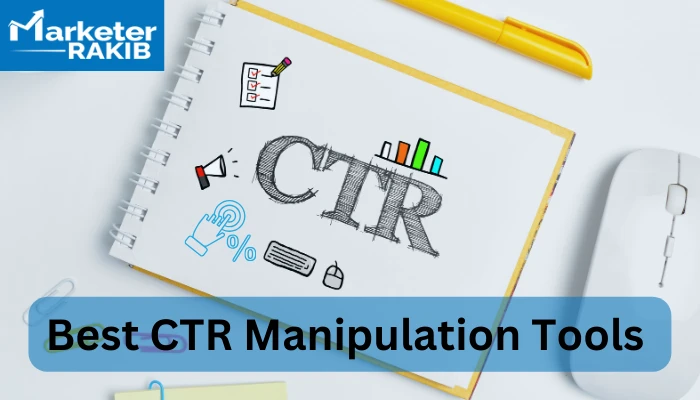Exactly How to Determine the Influence of CTR Adjustment on Your Advertising And Marketing
Recognizing the nuances of click-through rate (CTR) control in advertising is crucial for organizations striving for authentic customer interaction. By examining vital metrics such as conversion rates and bounce rates, marketing professionals can reveal possible disparities that may develop from fabricated enhancements.
Comprehending CTR Control
Recognizing CTR manipulation is necessary for online marketers seeking to enhance their projects and guarantee information honesty. Click-through rate (CTR) describes the ratio of customers that click a specific link to the total variety of customers who view the advertisement or web content. Adjustment of this metric can happen via different ways, including making use of misleading marketing strategies, click ranches, or automated crawlers. These techniques can synthetically inflate CTR figures, resulting in misguided marketing methods and misallocation of sources.
The effects of CTR manipulation prolong past mere information distortion; they can undermine rely on digital advertising and marketing. When services rely upon inflated metrics, they might buy ineffective projects, inevitably hurting their return on investment. Furthermore, systems might penalize marketers taking part in such techniques, bring about additional implications for their marketing efforts.
To efficiently deal with CTR manipulation, marketers have to establish an extensive understanding of their data resources and analytics devices. By utilizing sophisticated tracking techniques and looking at traffic sources, they can determine irregular patterns and ensure that their performance metrics show real user interaction - GMB CTR Manipulation. This caution is important for cultivating long-term success in a progressively competitive electronic landscape
Trick Metrics to Evaluate
Reliable evaluation of crucial metrics is essential for evaluating real efficiency of advertising campaigns and detecting possible CTR manipulation. One main metric to consider is the Click-Through Rate (CTR) itself, which represents the ratio of customers who click on an ad to the complete variety of individuals that watch it. An unexpected spike in CTR may suggest manipulation, requiring further investigation.
In addition, checking conversion prices is crucial. A high CTR with a reduced conversion price can signify that the clicks are not genuine or that the targeting is misaligned (CTR Manipulation Press Release). Analyzing bounce prices can offer insight into user involvement; a high bounce price after a click may suggest that the web traffic is not quality-driven.

Tools for Dimension

Additionally, A/B testing tools such as Optimizely or VWO can promote testing with various ad versions to figure out which aspects drive higher CTR. These tools permit online marketers to analyze real-time performance and make data-driven changes. Social media site analytics devices, like Hootsuite or Sprout Social, can also be important in comprehending CTR within social platforms, giving insights right into audience behavior and engagement patterns.
Furthermore, warm mapping devices, such as Hotjar, can reveal how customers interact with ads, aiding to determine where improvements can be made. Incorporating these tools develops a robust dimension structure, allowing online marketers to determine the effects of CTR adjustment properly. Inevitably, the best selection of measurement tools is critical for making informed advertising and marketing decisions and enhancing campaign performance.

Assessing Long-term Impacts
One must take into consideration the long-lasting results of CTR manipulation on general advertising and marketing performance, as temporary gains can commonly mask much deeper ramifications. With time, synthetically pumped up click-through rates may result in lessened trust fund from consumers and online search engine alike. When users continuously encounter misleading practices, they might become hesitant to engage with the brand, causing lower conversion prices in the future.
Additionally, formula updates from platforms such as Google are created to focus on genuine interaction over inflated metrics. Consequently, businesses that count on CTR manipulation may discover themselves punished, resulting in a decline in organic reach and exposure. This can have a cascading effect on brand reliability and consumer commitment, eventually threatening the extremely objectives that the initial adjustment looked for to attain.
Additionally, the information gathered from adjusted CTR may misinform marketers in their strategy advancement. Counting on skewed information can result in misguided projects that stop working to reverberate with the target audience, leading to wasted resources and missed out on opportunities. For that reason, it is essential for online marketers to analyze the long-term ramifications of CTR control and prioritize sustainable, ethical interaction strategies for lasting success.
Moral Considerations in CTR Control
In the realm of electronic advertising and marketing, honest considerations surrounding CTR manipulation are important source critical. While the wish to enhance click-through rates (CTR) can lead to short-term gains, the prospective long-term effects on brand name stability and customer trust can not be neglected.
Additionally, moral problems include conformity with laws such as the Federal Trade Compensation (FTC) guidelines, which mandate transparency in advertising and marketing. Falling short to comply with these criteria can reveal organizations to legal ramifications and harm their credibility. Marketing experts should take into consideration the effects of their methods on user experience and the wider industry landscape.
In addition, the surge of expert system and automation in advertising and marketing presents additional moral problems. The possibility for algorithmic prejudice or the exploitation of customer data questions regarding responsibility and fairness. Eventually, honest marketing practices need to prioritize openness, honesty, and regard for the consumer, fostering her response long-lasting partnerships that transcend simple metrics like CTR. Balancing efficiency with values is essential for lasting success in the electronic market.
Verdict
In verdict, gauging the influence of CTR control on marketing requires a comprehensive analysis of crucial metrics, consisting of click-through rates, conversion rates, and bounce rates. Utilizing analytics devices and conducting A/B screening can offer useful insights right into individual interaction and website traffic quality. Furthermore, assessing long-term impacts and sticking to honest factors to consider is important for informed decision-making. Ultimately, a data-driven method makes sure that advertising and marketing strategies are reliable and aligned with authentic user communications.
Recognizing the nuances of click-through price (CTR) control in advertising and marketing is essential for services aiming for authentic user involvement.Reliable analysis of vital metrics is critical for examining the true efficiency of advertising projects and finding prospective CTR adjustment.One have to think about the long-lasting impacts of CTR control on total advertising efficiency, as temporary gains can often mask much deeper effects.In the realm of digital advertising and marketing, honest considerations bordering CTR adjustment are vital.In verdict, measuring the impact of CTR control on marketing requires a comprehensive visit their website analysis of essential metrics, consisting of click-through prices, conversion rates, and bounce prices.